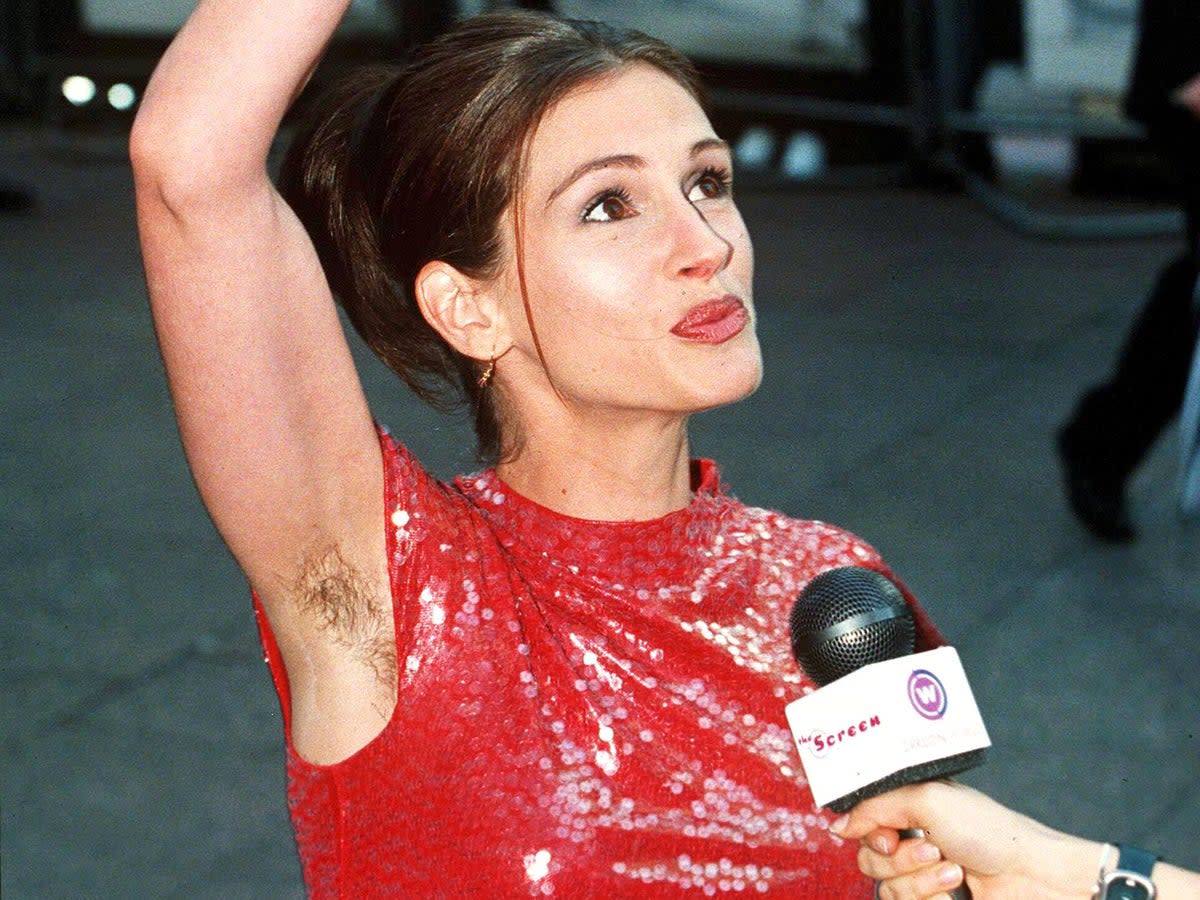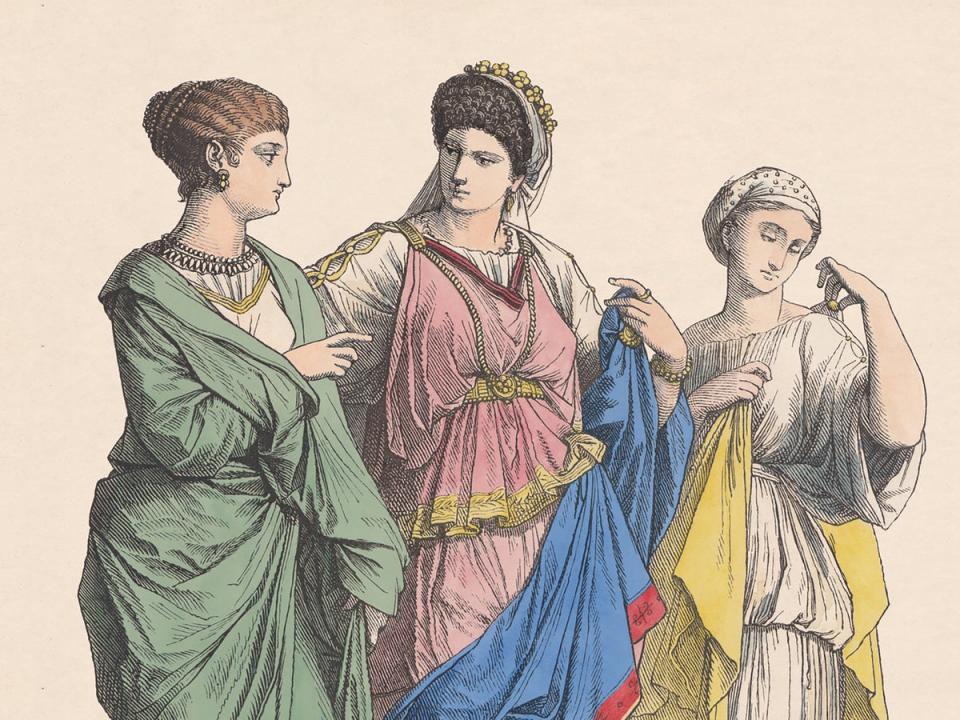Women with body hair remain a cultural taboo, and I can’t see it changing

The premiere of Notting Hill in 1999 was upstaged by Julia Roberts’ underarms. Wearing a sequined cowl neck Vivienne Tam dress on the red carpet, Roberts waved to her adoring fans by lifting up her arms, revealing two dark tufts of hair. The tabloids were in disarray. The next morning, conversation was more focused on Roberts’ armpits than her actual performance, as people questioned what had possessed the glamorous Pretty Woman star to go against the ideals of femininity so publicly.
Speculation about her motives ranged from it being a radical feminist statement, to the preferences of her then-boyfriend Benjamin Bratt. Except it wasn’t calculated. Roberts revealed almost 20 years later that it wasn’t a revolutionary feminist act – she simply didn’t shave.
More recently, Mean Girls actor Rebecca McAdams bared some fluff as she draped herself across a chaise lounge on the cover of Bustle magazine – people similarly gawped. There was nothing gargantuan or obscene about the size of the tufts underneath her arms, yet they were all anyone could seem to talk about. Depending on what social media accounts you looked at in the hours after the shoot dropped, McAdams was either “disgusting” and unkempt or a feminist icon.
Both pit displays unintentionally or intentionally went against the hair removal culture that’s told women to have all of their skin as smooth as a dolphin’s – the more likeness to a newborn baby, the better. It’s discouraging to think that despite their respective hair incidents occurring two decades apart, Roberts and McAdams both received similar reactions. And though there have been many attempts from women in recent years to normalise it, we can’t seem to get away from the idea of femininity equalling hairlessness.
How did we even get here? New evidence unearthed by English Heritage suggests we should blame the Romans for our compulsion to wax, laser and epilate our way to silky skin. Last Thursday, dozens of artefacts went on display at Wroxeter Roman City in Shrewsbury – once the fourth largest town in Roman Britain – revealing the beauty habits of our bath-obsessed ancestors. Prominent among the collection were tweezers made of bronze or copper alloy, with historians concluding that Roman men and women similarly plucked themselves to perfection.
Cameron Moffett, English Heritage curator at Wroxeter, tells me that Roman men were keen on removing their body hair, apparently to partake in their sport of choice: wrestling. “There was a particular wrestling aesthetic where the men would only wear a loincloth,” she explains, pointing towards the nappy-style briefs worn by the wrestlers. “If you were exposing your body, particularly your armpits and your back, you were expected to have had your hair removed.” It’s at this point I picture gaggles of Roman men lounging around a Roman bath innocently tweezing the hairs from each other’s backs.
Moffett tells me that more than 20 tweezers were found in the excavation process nearest to the bathhouse and basilica (where exercise would take place), which has led archaeologists and historians to conclude that hair removal was part of the communal bathing culture that the Romans took pride in. For the men, the standard was to be hairless and muscular and to exercise to keep healthy. The women, Moffett says, were expected to work even harder.
People would use a chemical made out of thallium acetate [to remove hair], which turned out to kill several people and caused permanent damage to a lot of other people
Rebecca Herzig
It is thought that women were encouraged to remove their underarm hair to appear attractive to men, while also paying attention to their facial features and hairstyle. “The idea that women needed to shave to be desirable was embedded in Greco-Roman culture,” explains Moffett, adding that women devoted time to styling their hair – something evident in hairpins found during archeological excavations. “The women were seeing coinage coming from the Mediterranean and they were following the hairstyles of the heads appearing on the coins. They had something to work from.” Moffett also speculates that women may have pruned their pubic hair when they attended the public baths, but there’s no concrete evidence to confirm whether the bush was mowed or embraced.
Hair removal was not unique to the Romans, though, with others using chemicals and peculiar tools to remove hair up until the modern period – sometimes going to extreme lengths. “A lot of people have died for this,” says Rebecca Herzig, professor of Gender and Sexuality studies at Bates College in Maine and author of Plucked: A History of Hair Removal. Herzig tells me that in the early 20th century, people would use dangerous materials to remove hair. “People would use a chemical depilatory made out of thallium acetate, which turned out to kill several people and caused permanent damage to a lot of other people.” Herzig dedicates a whole chapter of her book to the ways people have endured painful and potentially lethal methods of hair removal – a far cry from the sulfurous stench of Veet. “One of the things that struck me during my research is that people’s intensity of feeling about body hair is very high,” she says.
The classification of hairlessness as a requirement for women still goes hand-in-hand with the assumption that being hairy also means being radical or undesirable. But, as Herzig tells me, there has long been an interesting relationship between unshaven women and feminism, linking back to the second-wave feminist movement in the United States in the 1970s. Feminists who pushed back against the idea that feminine bodies needed to be hairless – and thus embraced their natural fluff – were often stigmatised for being “disgusting hairy women”.

The normalising of hairlessness has been most prominent in mainstream porn, where women are often shaved from the shoulders down, much like Barbie dolls. But women continue to rally together to remind the world – and each other – that hair growth is nothing to be ashamed of. In 2017, American model Amber Rose shared a now-removed nude picture in which she could be seen reclining on a shallow staircase and showing off her pubic hair, captioning the post #bringbackthebush. The tuft was styled in what experts might call a “landing strip” (Google will be your friend here). Then, in 2019, the unicorn armpit trend went viral, in which women began dying their underarm hair in different shades of the rainbow. Today, armpit hair has become the latest performative feminist accessory, just like wielding a copy of a Florence Given book, or women posting pictures of their best girlfriends on International Women’s Day.
Some may argue that Gen Z – my generation – will be the ones to normalise body hair once and for all. I’m sceptical, though. I fear that as long as we celebrate hairiness as some kind of triumph of womanhood, it erases the middle ground for normalcy. Sure, it takes a certain bravery to conquer the embarrassment we’ve been taught to attach to body hair, but what about those who just want to grow their hair in peace? Does it have to be political? Julia Roberts didn’t intend to make a feminist statement in 1999; she just didn’t really care. And simply not caring doesn’t have to be a victory for the masses.


